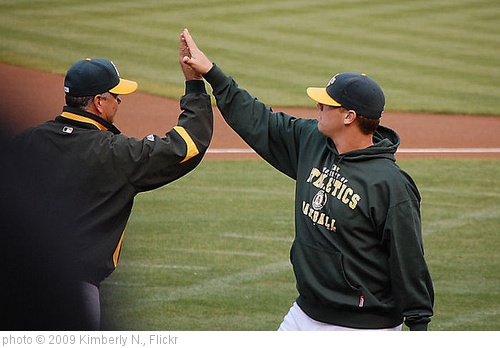By now you’ve probably heard the news about our new closer. If not, here’s the scoop from the Boston Globe’s Peter Abraham:
“The Red Sox took a gamble when they acquired Andrew Bailey from the Oakland Athletics in December. The righthander unquestionably had the talent and temperament to replace Jonathan Papelbon as the closer, but had a troubling history with injuries.
Now, just days before the season starts, Bailey has been told he needs surgery on his right thumb, according to major league sources.”
I knew I should have started an Andrew Bailey injury pool! Ah, such is life. Full of so many missed opportunities.
Seriously though. Bailey’s injury poses a rather interesting problem for the Red Sox. For starters, their bullpen was already pretty thin. Bailey sat at the top as the closer with former Astros closer, Mark Melancon, setting him up. While this closer/set-up combo has the potential to be very strong, the rest of the bullpen is full of question marks. Maybe I’m being overly negative, but Michael Bowden, Scott Atchison, Franklin Morales, and Matt Albers don’t exactly instill a ton of confidence. Additionally, there’s no doubt that its a downgrade after the Jonathan Papelbon-Daniel Bard 1-2 punch that was among the best in baseball last season, providing 4.8 fWAR in value. Now, with Bailey out for at least 3-4 months, their bullpen is further compromised. Who closes? Who serves as the primary set-up man? What is the long-term plan if Bailey suffers a set back in his recovery? All of these questions need to be answered fairly quickly, and Opening Day is just around the corner.
Who will be the closer?
For now, the obvious choice seems to be Melancon. He was the closer in Houston last season and did an admirable job saving 20 games, while posting a 3.25 FIP with solid peripherals. While he lacks the big fastball of Papelbon and Bard, he has two pitches, a change-up and a nasty curveball, that induce plenty of whiffs. Last season, his curveball alone had a whiff/swing rate of nearly 40%, which demonstrates the pitch’s effectiveness. Also working in his favor is his ability to coax batters into hitting ground balls. While ground ball pitchers tend to give up more hits than their fly ball counterparts, they also benefit from the occasional double play. (He had six in 74-1/3 innings in 2011.) Additionally, the infield defense is pretty solid (especially on the right side), so he should be ok on balls in play.
Bard will also be mentioned as a potential closer candidate, but I don’t see that being feasible. They spent all winter and spring with the expectation he would be stretched out to be a starter. On Sunday, he was officially named the fifth starter by Bobby Valentine. I can’t imagine any scenario where they’d drastically change course now, and slot him into the closer role. If he struggles mightily over April and May, I can see them potentially moving him back to the bullpen. Still, even if that happens, they’ll probably move him into a lower leverage role in order to help him regain his confidence.
Who will be the primary set-up man?
With Alfredo Aceves being removed from consideration as a starting pitcher, he becomes the most likely candidate to be the Red Sox’s primary set-up man. Considering his versatility, this could be a great role for him; especially if he’s used like Bard was last year. Ideally, Valentine would use him in the highest leverage situations, rather than just the eighth inning. This would allow the Red Sox to put out the most important fires, while leaving lesser relievers to pitch in lower leverage situations with no one on and no one out.
Outside of Aceves, the options are pretty limited. Morales is the most promising choice out of the remaining bunch. He has excellent velocity, and a solid array of secondary pitches; all of which are capable of inducing whiffs. On the surface, he seems like the ideal primary set-up man. Unfortunately, his control is pretty inconsistent, as evidenced by his 12.2% career walk rate. He showed some improvement last season after he was acquired (8.2% in Boston), but he’ll have to prove it wasn’t a fluke before he gets this opportunity.
Albers held down the seventh inning duties after Bobby Jenks went down with a back injury. He did a pretty admirable job until August 1st, and then he completely fell apart. He has a lot of work to do to rebuild his reputation in Boston before he’ll get similar opportunity.
Bowden, who was Pawtucket’s closer last season, is another option, but he needs to prove he can get major league hitters out consistently. Until he does, he’ll be given low leverage work out of the bullpen.
What is the long-term plan if Bailey suffers a setback?
Contrary to popular belief, contending teams don’t need a great pitcher at the back of their bullpen closing games. It certainly helps, but it is by no means a requirement. For example, the Tigers, Rays, and Cardinals all made it to the playoffs with Jose Valverde, Kyle Farnsworth, and Fernando Salas leading their respective teams in the saves department. I don’t think anyone would call them great closers, let alone great pitchers. Furthermore, the White Sox (2005) and Cardinals (2006) each won championships with closers that weren’t encumbered in their roles until the playoffs. With most closers entering the game with a 1-3 run lead with the bases empty, a serviceable reliever that can strike batters out is usually sufficient in the ninth inning.
Whether the Red Sox are without Bailey for either the short-term or long-term, they shouldn’t have any problems finishing off games. Though not ideal, Melancon is more than capable of filling the role in the interim. If things don’t work out as planned, the Red Sox have the option to look externally for viable “value” candidates to fill the role.

